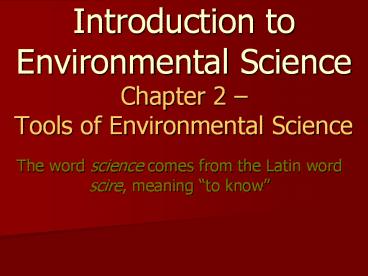Introduction to Environmental Science Chapter 2 – Tools of Environmental Science - PowerPoint PPT Presentation
1 / 36
Title:
Introduction to Environmental Science Chapter 2 – Tools of Environmental Science
Description:
Introduction to Environmental Science Chapter 2 Tools of Environmental Science The word science comes from the Latin word scire, meaning to know – PowerPoint PPT presentation
Number of Views:603
Avg rating:3.0/5.0
Title: Introduction to Environmental Science Chapter 2 – Tools of Environmental Science
1
Introduction to Environmental ScienceChapter 2
Tools of Environmental Science
The word science comes from the Latin word scire,
meaning to know
2
Goals and Objectives
- Describe steps that scientists use to solve
problems in our environment - Describe how statistics and models are used to
solve problems - Use a simple environmental decision-making model
3
What Science IS and IS NOT
- Science is an organized way of studying the
natural world, and the knowledge gained from such
studies (experimental method) - Science assumes that the natural world functions
in accordance with rules that do not change. - Science does NOT deal with the supernatural
- Science relies on evidence from measurements and
observations - Scientific ideas are supported not proven,
and accepted not believed in
4
How Science Works
- In order to satisfy our curiosity about why
things are the way they are and about how things
happen the way they do, we must - Make Observations using our senses and tools to
gather information - What are some tools a scientist may use?
http//www.ted.com/talks/beau_lotto_optical_illusi
ons_show_how_we_see.html
5
Observations
Make some observations from this photo
6
Make some observations
7
Observation
8
Observation
9
Hypothesis and Predicting
- A testable explanation of an observation that
can lead to further investigation - A logical statement about what will happen if the
hypothesis is correct - Can you give an example?
10
Hypothesis
11
Hypothesis
12
Hypothesis
- Cholera is caused by people drinking contaminated
water. - Which pump appears to be causing the 1854 London
Cholera outbreak? - Spot Map
- See patterns in data
- How could you test this hypothesis?
13
Collecting Data
- To study the hypothesis data are collected and
analyzed (experiment) - Conclusions are drawn
- Results must be repeatable
- Results are communicated
- Subject to peer review
14
Correlation
- Used when experimentation is impossible or
unethical - Reliable association between 2 or more events
- Not necessarily cause-and-effect relationship
15
Collecting Data
16
Collecting Data
17
Drawing Conclusions
18
Repeating Experiments
19
Communicating Results
20
What does this model show us about how mercury
gets to humans?
21
Community Analysis and Feedback Peer Review
Present their work and get feedback from other
researchers at conferences Write papers about
their study Submit papers for publication in a
journal
22
Habits of a Scientist
- Curiosity
- Skepticism
- Openness to New Ideas
- Intellectual Honesty
- Imagination and Creativity
23
What is going on here?
1999 Earthquakes in yellow
24
(No Transcript)
25
How can we use scientific methods to study our
impacts on the environment?
26
Environmental ethics is the application of
ethical standards to the relationship between
humans and the environment. Anthropocentrism
Humans and human welfare most important Biocentris
m All living things have value some may be more
important than others Ecocentrism Well-being of
a species or community more important than that
of an individual
27
Statistics Models
- Statistics is the collection and classification
of data that are in the form of numbers.
28
Probability, Sample Risk
- Probability the chance that something will
happen - Sample group of individuals or events chosen to
represent the population - Risk probability of an unwanted outcome
29
Thinking About Risk
- The most important risk we consider is the risk
of death. - Most people overestimate the risk of dying from
sensational causes, such as plane crashes, but
underestimate the risk from common causes, such
as smoking. - Likewise, most citizens overestimate the risk of
sensational environmental problems and
underestimate the risk of ordinary ones.
30
Models
- Physical 3d models you can touch
- Graphical used to show things (maps, charts)
- Conceptual verbal or graphical explanation of
how a system works or is organized - Mathematical equations that repreent the way a
system or process works
31
Physical Model
32
Graphical Model
33
Conceptual Model
34
Mathematical Model
- I PAT is the lettering of a formula put forward
to describe the impact of human activity on the
environment - I P A T
- In words
- Human Impact (I) on the environment equals the
product of P Population, A Affluence, T
Technology - This describes how our growing population,
affluence, and technology contribute toward our
environmental impact.
35
Making Informed Decisions
- Decision Making Model
36
Making Informed Decisions































